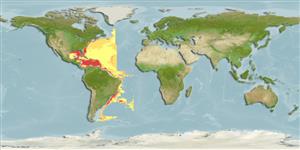Teleostei (teleosts) >
Trachichthyiformes (Roughies) >
Trachichthyidae (Slimeheads)
Etymology: Hoplostethus: Greek, hoplon = weapon + Greek, stetho, stethion = brest; literal = to prick a little breast (Ref. 45335).
Environment: milieu / climate zone / depth range / distribution range
Ecology
Marine; bathypelagic; depth range 485 - 550 m (Ref. 9869). Deep-water
Atlantic Ocean: southern Nova Scotia south to the northern part of the Gulf of Mexico, on the eastern seaboard of Florida, in the Bahama, in the west and southern Caribbean, and around Venezuela, Guyana, Suriname, Tobago and Brazil.
Size / Weight / Age
Maturity: Lm ? range ? - ? cm
Max length : 17.3 cm SL male/unsexed; (Ref. 37108)
Dorsal spines (total): 6; Dorsal soft rays (total): 13; Anal spines: 3; Anal soft rays: 9. Pectoral fin long, its tip extending beyond anal fin origin (Ref. 13608). Scales adherent, spinules small, margins serrate, spines on fin rays small. Denticles on head bones small, septae relatively strong (Ref. 37108).
Life cycle and mating behavior
Maturities | Reproduction | Spawnings | Egg(s) | Fecundities | Larvae
Kotlyar, A.N., 1986. Systematics and distribution of species of the genus Hoplostethus Cuvier (Beryciformes, Trachichthyidae). Trudy Inst. Okeanol. 121:97-140. (Ref. 9869)
IUCN Red List Status (Ref. 130435)
Threat to humans
Harmless
Human uses
Fisheries: of no interest
Tools
Special reports
Download XML
Internet sources
Estimates based on models
Preferred temperature (Ref.
123201): 8.3 - 13.5, mean 9.4 °C (based on 21 cells).
Phylogenetic diversity index (Ref.
82804): PD
50 = 0.5000 [Uniqueness, from 0.5 = low to 2.0 = high].
Bayesian length-weight: a=0.01660 (0.00723 - 0.03808), b=3.05 (2.85 - 3.25), in cm total length, based on LWR estimates for this (Sub)family-body shape (Ref.
93245).
Trophic level (Ref.
69278): 3.6 ±0.59 se; based on food items.
Resilience (Ref.
120179): Very Low, minimum population doubling time more than 14 years (Preliminary K or Fecundity.).
Fishing Vulnerability (Ref.
59153): Low vulnerability (11 of 100).
